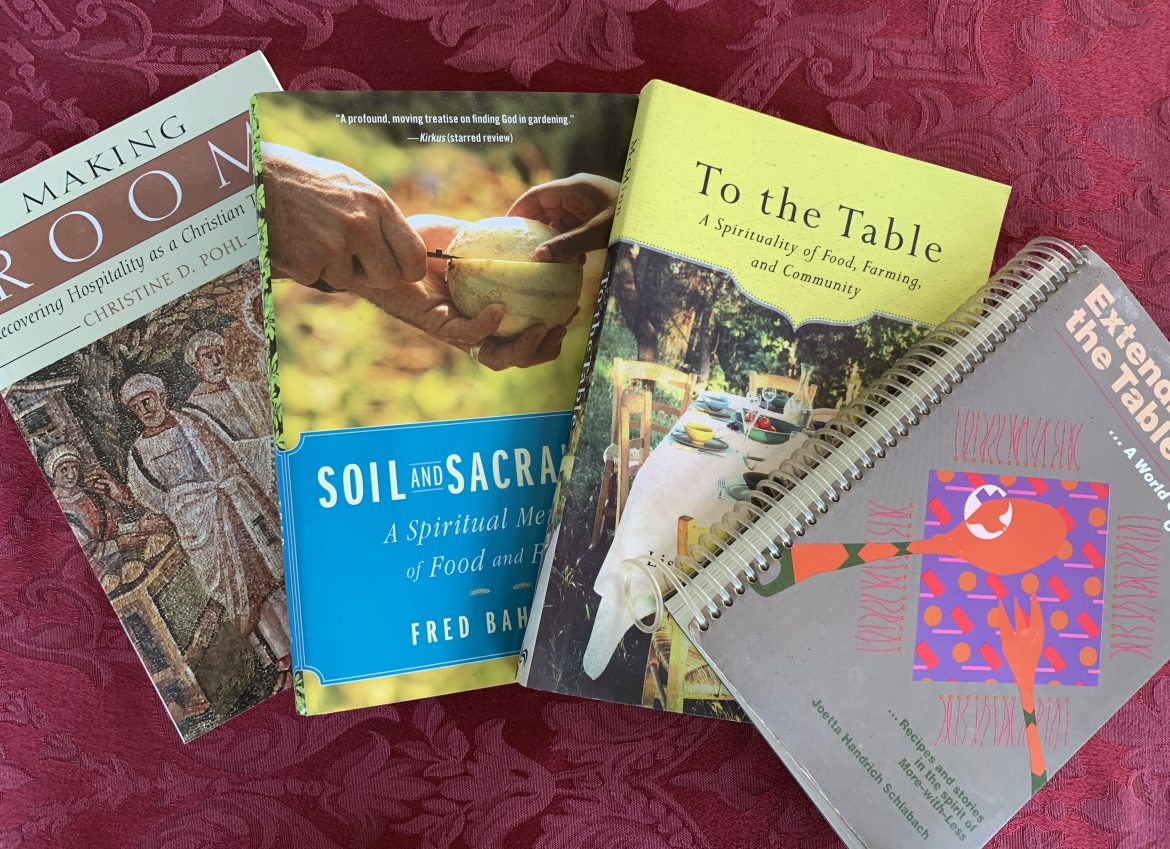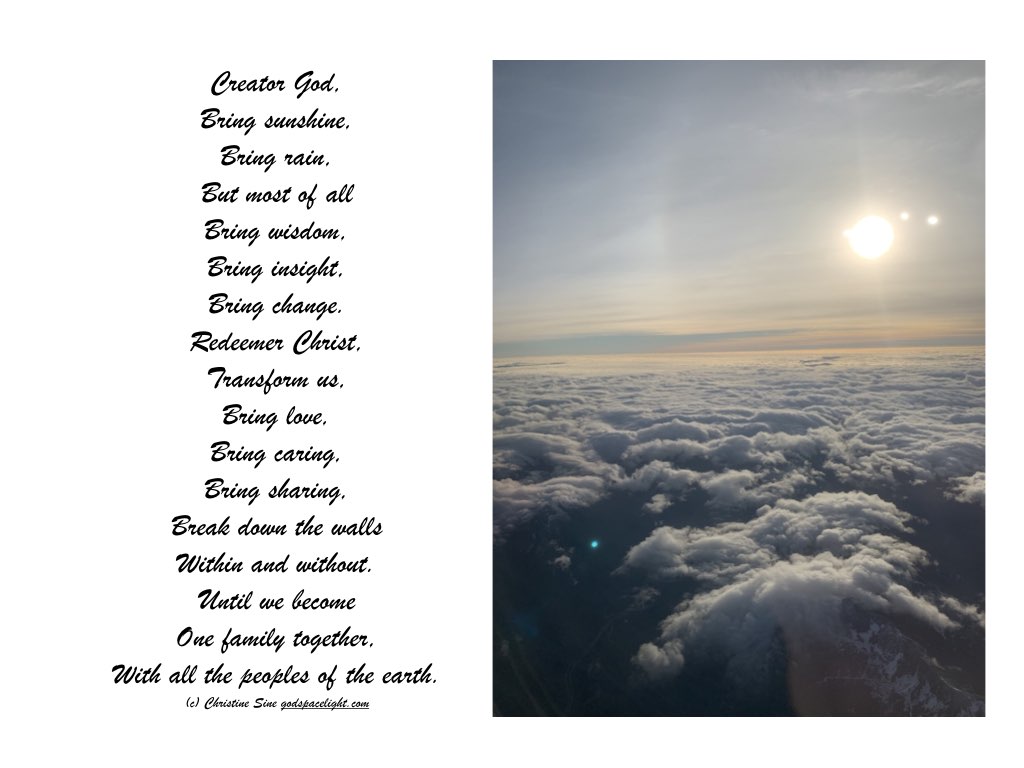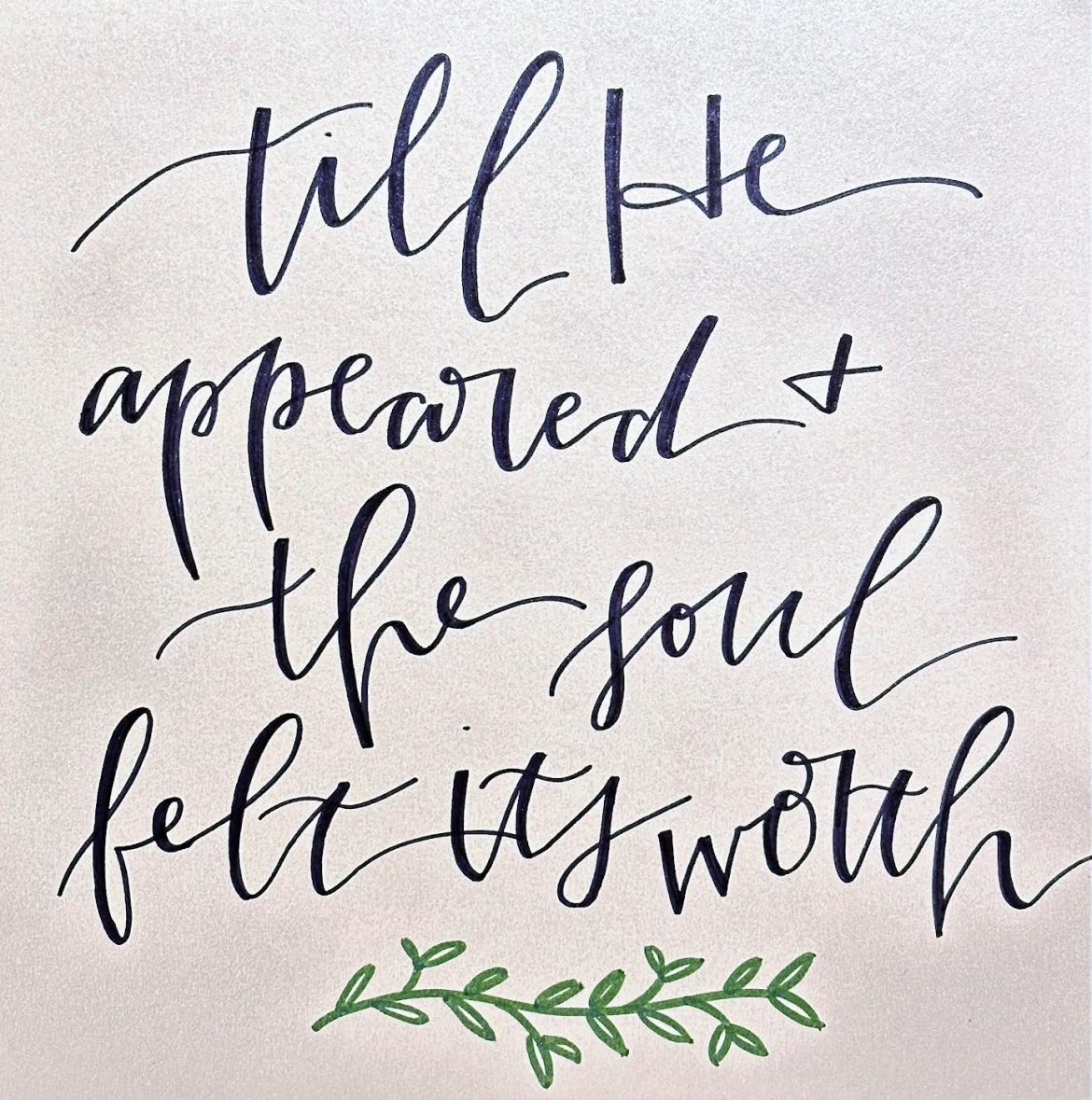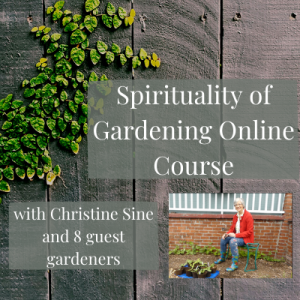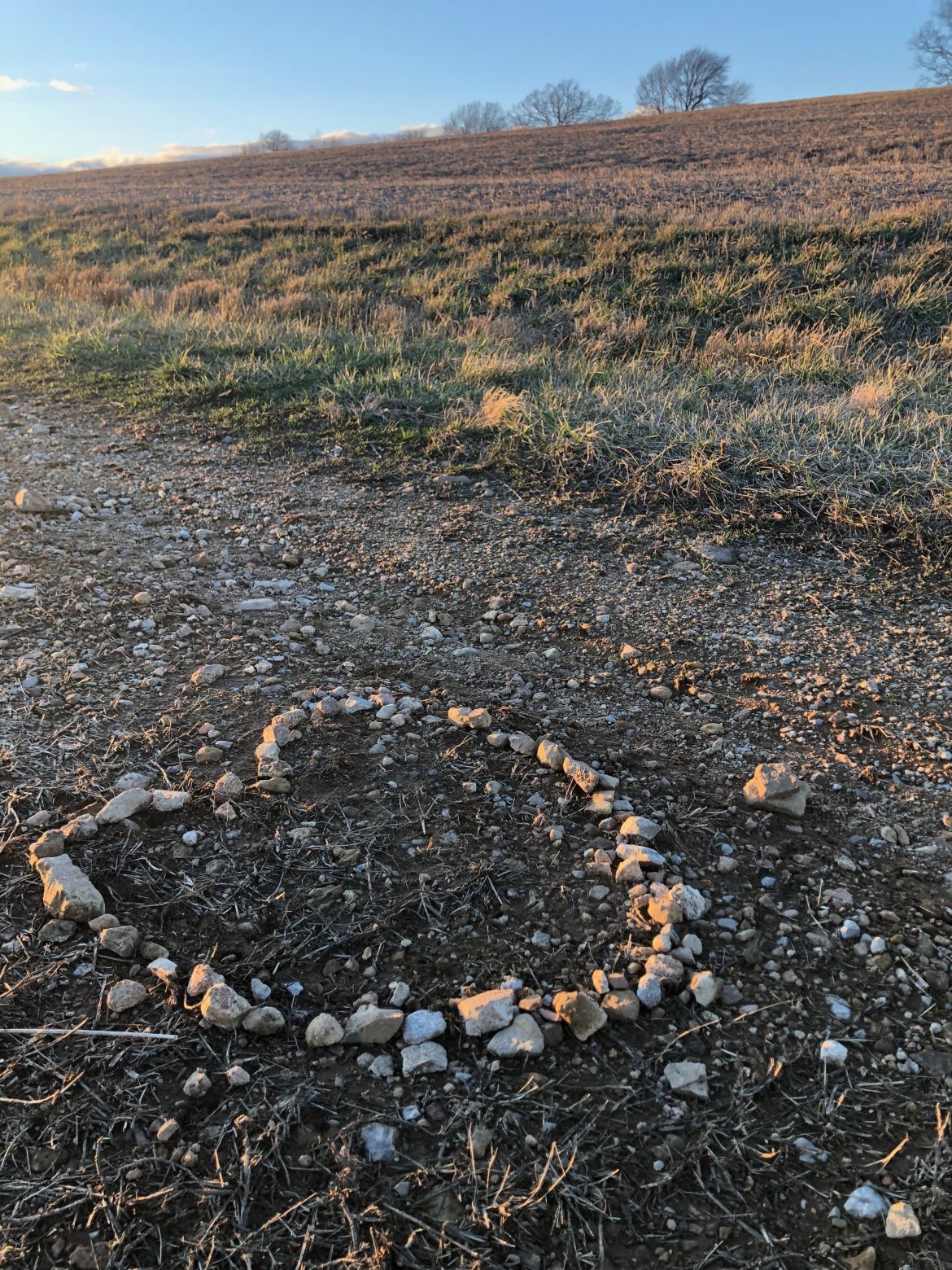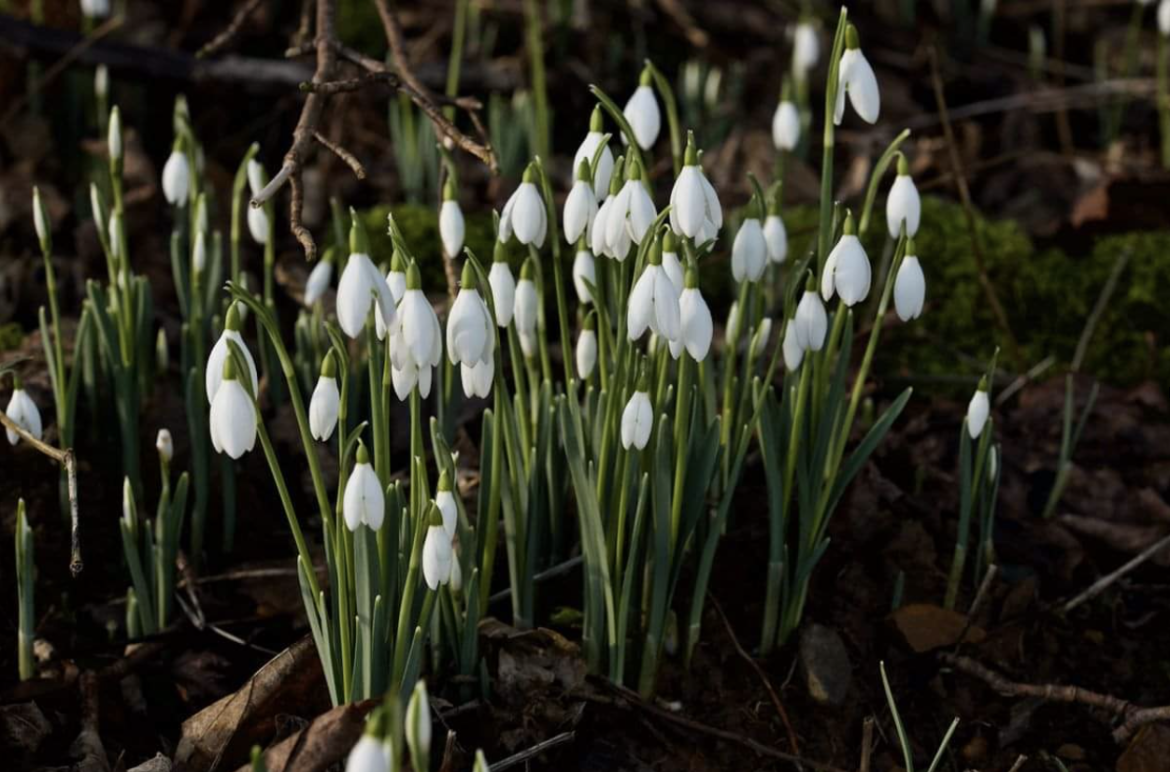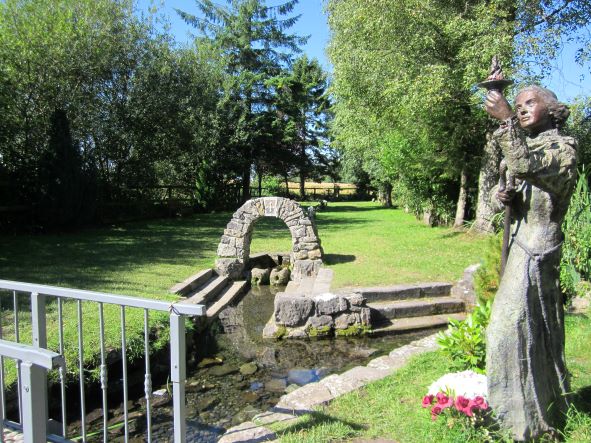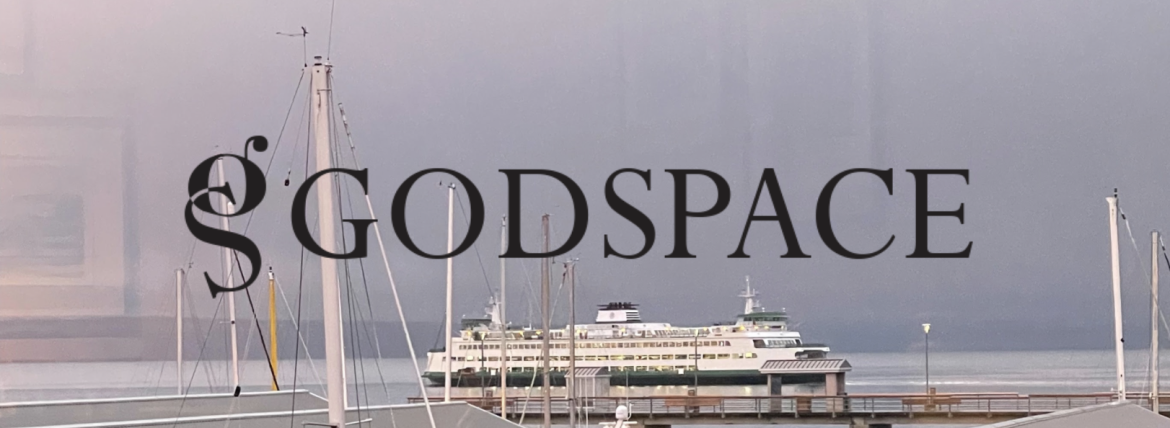As we move into the year, I wanted to revisit our list of hospitality resources. Reaching out to our community and offering hospitality to our neighbors is a great way to feel connected, especially for those of us deep in the winter months.
Hospitality was our theme several years ago and I have just revisited this enriching series of articles. I thought you might like to revisit them too.
Here are a few of my favorite books on hospitality to get you in the mood.
Last week Khouria Destinie of Ascetic Life of Motherhood introduced me to the Triodion, the Orthodox liturgical book containing the hymns and services for the period from now until Holy Saturday. I was surprised to see that this book and the worship rhythm of Orthodox Christianity begins not with Ash Wednesday but with a three week pre-Lent period of preparation. It began yesterday with the Sunday of the Publican and Pharisee and moves through progressive Sundays highlighting the story of the Prodigal Son, Last Judgement and forgiveness.
The Orthodox calendar might be different from the one you are used to. Great Lent begins on February 27th whereas for most of us Lent begins on February 22nd with Ash Wednesday. What I love is the dedication of the Orthodox pattern of worship, which includes not only 40 days of fasting during Lent itself, but three serious weeks of preparation before that to prepare our hearts and minds for the season. This is such an important time in the celebration of our faith that I think all of us need to give it our full attention now.
My personal Lenten theme for this year, as well as the theme for Godspacelight is “Breaking Down Walls”, a theme we also used in 2019 as our justice focus for the season. When I suggested this to our writers, Elaine Breckenridge commented:
I am pleased that the theme for Lent will revolve around justice. However I do struggle with the metaphor, “Breaking Down Walls.” I know it is a metaphor. But metaphors evoke pictures. Seeing walls knocked down looks violent to me. When I think of Gandhi and Dr. Martin Luther King, I see images of passive resistance on the part of those working for justice. When I think of Desmond Tutu and his great work in South Africa, I see images of people talking with one another and reaching reconciliation. It seems to me justice is an expansive and creative work steeped in peace, not destruction.
She is right, breaking down walls can be a violent act, though it can also be an act of release, of love and of hope, as walls separate us from each other and keep us isolated from the pain of our world. I must confess however, that when I first read her comment I thought “but I would want the bridges to smash the walls” because it is my experience that bridges can only be built when walls have started to fall. I think of some of the walls I have seen fall in my lifetime. The Berlin Wall, which I visited in the 1980s and kept a piece of until recently when I gifted it to a friend, taken from the wall by a German friend, who together with others prayed for years for the breaking down of the wall. The statues of Stalin in Poland, some of which I saw torn down after the country’s release from the Soviet Union. The wall of silence about black deaths at the hands of the police in the U.S., the barrier to people crossing from Mexico to the U.S., our confrontation with the consequences of climate change are examples of wall that are still in the process of being broken down. Unfortunately none of these walls came down without violence, even though the crumbling of the walls themselves were not violent acts. In fact they were acts of freedom and liberation.
Sometimes we need to break down walls so that we can build bridges. If we build bridges when the wall still exists, we still have barriers to peaceful, freedom giving action. What we need to work towards is a society of justice and understanding and compassion in which walls are not thought to be necessary.
In 2019 Fran Pratt wrote a beautiful Litany about breaking down walls
If we can forget the idea of separation,
Perhaps we can stop building walls on its behalf.
Oh God, may we let love have free reign
To build something more imaginative than walls.
When love has free reign there are no walls, so I suggest we work to break down the walls of separation and build bridges where those walls once stood.
Breaking Down Walls Means Listening Carefully and Respectfully.
Walls are so often designed to keep out people or ideas we see as a threat, without really understanding who the people are or what the ideas mean. To listen carefully and respectfully, we must be secure enough in who we are to not be threatened by another person’s opinion. What are the fears that make us feel walls are necessary, not just on the border, but in other parts of our lives too? Listening does not mean we agree with each other, but hopefully it does mean that we can accept and love each other in the midst of our disagreements and work to build bridges rather than walls.
What if we decided to break down these walls for Lent and truly listened to each other? Here are some suggestions on how to do this.
1. Let’s preach a theology of inclusion. So often we create walls between us and those who look or practice faith differently than we do because we focus on difference rather than similarity. We are all created in the image of Christ and Paul reminds us in Galatians 3:28 that, “There is no longer Jew or Gentile, slave or free, male and female. For you are all one in Christ Jesus.” What does that look like in our world today? How could we use Lent to break down walls that exclude other ethnicities, other denominations and other sexual orientations?
Why not visit a church of a different denomination each week during Lent – an African American church, a Catholic Church an Orthodox Church, a LBGTQ affirming church or a very conservative church. If there is a church with mainly refugees in your area, it would be good to include that as well. You might even like to add a mosque and a Jewish synagogue to the mix. Invite your friends to join you. Have a discussion afterwards asking: What did you learn about God? And what did you learn about faith?
2. Encourage practices that help you get to know your neighbors. Random acts of kindness in the neighborhood are great ways to break down walls that isolate us from those around us. One of the positive impacts of the COVID lockdown was that many of us got to know our neighbours and our neighborhoods. People reached out to help those who lived alone. We walked around the neighborhood and talked to people we had never met before. Our neighbors brought us groceries every week. These are practices we still need. Maybe Lent this year is a time to reach out once more to those who live near us.
3. Be open to change. When we interact with people who are very different from us, we must be willing to learn and be receptive to the change God may demand of us. I am still impacted by the words of African American preacher Leroy Barber who once told me, “white people want us to show up but they don’t want us to change how we do things.” We need to encourage flexibility and a willingness to both see things differently and do things differently.
4. Share in the pain of the excluded. When we listen to the stories of other people’s pain, we have the choice of strengthening the walls that divide us by turning away from or ignoring the suffering that overwhelm us. Alternatively, we can take the pain we hear expressed into ourselves in the same way that Jesus took on the pain and suffering of the world. Then, we must allow God to comfort us in the midst of that pain and share that comfort and compassion with others. Teaching our congregations to listen to the pain of others and respond in compassionate and caring ways could be one of the most powerful things we could teach during Lent. Listen, pray, respond is a great mantra to teach our members to use during Lent.
5. Encourage practices that break down the wall to climate change denial. All of us live in denial to a certain extent because we are overwhelmed by the implications of the disaster of climate change and human culpability in creating it. We need to both educate ourselves and our neighbours to the consequences and help institute solutions. We just signed up to have solar panels installed on our roof and during Lent this year I plan to look at other steps we can take to make our way of living more sustainable.
Lent is meant to be a season that prepares us to live more effectively as followers of Christ. And that is all about breaking down walls that exclude and isolate us. What will you do to prepare to break down the walls within yourself and your congregation during this season?
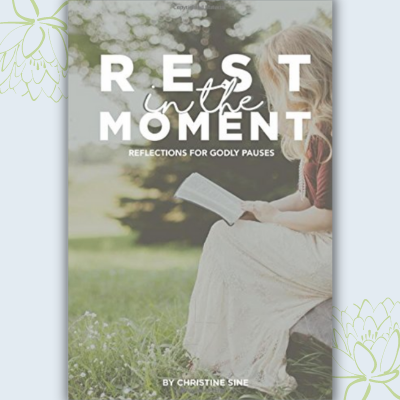 The twelve meditations in this beautiful full-color book are designed to provide moments of refreshment throughout the day or week. The blending together of prayers, reflections, questions, and photos invites us to pause, reset and refresh ourselves. Rest is such an important part of the rhythm of our lives, not just a weekly rest of Sabbath, but pauses of rest throughout the day to reset our focus and renew our connections to God. Enjoy as a PDF download, or purchase the hard copy here.
The twelve meditations in this beautiful full-color book are designed to provide moments of refreshment throughout the day or week. The blending together of prayers, reflections, questions, and photos invites us to pause, reset and refresh ourselves. Rest is such an important part of the rhythm of our lives, not just a weekly rest of Sabbath, but pauses of rest throughout the day to reset our focus and renew our connections to God. Enjoy as a PDF download, or purchase the hard copy here.
Artwork by Anna Huff
A prayer from Emily Huff
You Came
Thank You for coming into our stories,
into our brokenness,
into our self-doubt.
Thank You that you came to break the cycle….
of the ways we wound our lives, the lives of others, and the life of the
world….
Thank You that You came to break the cycle….
of the hierarchies we have created
that only serve to distance us from You,
from others,
and from ourselves.
You came
and our souls felt our worth.
You came
to bring us a life abundant
imbued with
a theology of worthiness1This phrase is from Erin Wathen’s powerful book Resist and Persist: Faith and the Fight for Equality.,
a theology of enoughness.
Certainly the epic drama of redemption is far from over,
but the message is this:
You came.
You came.
Thank God,
You came2The last lines of the prayer are from this beautiful reflection from Brian Kershisnik about his painting called “Nativity”..
_____________________________________________________
1 This phrase is from Erin Wathen’s powerful book Resist and Persist: Faith and the Fight for Equality
2 The last lines of the prayer are from this beautiful reflection from Brian Kershisnik about his painting called
“Nativity.”
~ Goodfellow
Explore the wonderful ways that God and God’s story are revealed through the rhythms of planting, growing, and harvesting. Spiritual insights, practical advice for organic backyard gardeners, and time for reflection will enrich and deepen faith–sign up for 180 days of access to work at your own pace and get ready for your gardening season.
I praise you because I am fearfully and wonderfully made; your works are wonderful, I know that full well. Psalm 139:14
Last week, I celebrated my birthday at the Abbey of Gethsemani, doing my annual silent retreat. It’s the birthday gift I give to myself each year. And the practice of silence is truly a GIFT, and a life saver for me!
Birthdays… some people like them, some people dread them. Some people have a favorite meal or birthday cake each year, some go out to celebrate, some throw parties for themselves. I’ve done all of those through the years. In high school I would request carrot cake with cream cheese frosting. I was not always happy about my birthday because we often had exams in January. I dreaded turning 40! I even sat in the car and wouldn’t go into the surprise party that my friends were throwing for me. (I had talked my husband into telling me there was going to be one.) My problem? I hadn’t accomplished everything on my “to do before 40 list” so I was disappointed in myself! I wasn’t looking at all the things I had done, but the things I hadn’t done! Turns out these great friends didn’t do an “over the hill party,” but instead, it was a beautiful “40 Years of Love” party! My good friend Suzanne made beautiful paper hearts with red ribbons writing things she loved about me on the hearts and declaring 40 years of love all over the room! I am so grateful for friends who remind me of who I really am! How about you? Who are those friends in your life?
Turns out my 40s were amazing! It was in my forties that God taught me all about creating Sacred Space and experiential worship. My Sacred Space came out in my 40’s. So I was upset for nothing!
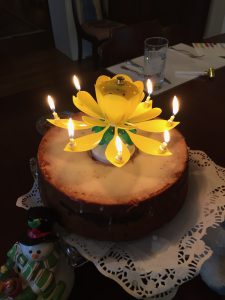
Birthdays give us an opportunity to look back and look forward to celebrate who we are and where we’ve been.
To take a look at what makes you, YOU, and take time to celebrate that!
What do you like about yourself?
What are you grateful for today?
What would you like to heal?
What would you like to learn more about?
How can you celebrate who you are today even if your birthday is months away?
Try a Birthday Examen Practice today
First feel God’s amazing love surrounding you!
Second, what are you grateful for in your life? As Father Michael Sparough says, not a list of things but rather a savoring of the gifts in your life, your talents, the people God has brought to you and are in your life now. Your faith and the journey you’ve been on with Jesus.
Opportunities you’ve had …gifts of the spirit in your life…generosity, patience, kindness etc
Take some time to truly be grateful today.
What about feelings? How have you felt about your life? Maybe you’ve been disappointed, hurt, suffered had heart breaks, set backs …talk to Jesus about these! The God of love is loving you, smiling at you, holding you ! NOT JUDGING YOU.
LISTEN to what Jesus says to you! Allow Him to love you even in the hard memories. Give Jesus the negatives to hold and carry for you.
Finally, LOOK FORWARD in HOPE! What are the good things, the things you want to take into this year ahead? In our Following the Star Epiphany Retreat, Christine helped us consider the intentions, rather than resolutions, we want in the new year.
I want to be more intentional with my friendships, building community, and practicing hospitality again. The pandemic really messed that up, and as an extrovert, I really need people! The people who help me connect with Jesus and who I really am!
I want to be more intentional with my self care. Too often I help everyone else but I don’t leave time or space for taking care of myself. Kind of like the shoe maker whose kids don’t have shoes!
Sit for a while and imagine Jesus smiling at you and listening to you as a dear friend would over coffee or tea. Listen to Jesus. Sit with Him in His LOVE.
As you look ahead, ask Jesus for the GRACE you need for the new year. Feel His loving arms surrounding you!
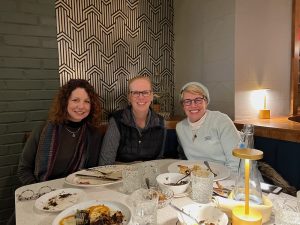
Celebrating with Friends
Take time to connect with those friends who remind you of who you really are! Give them a call, go out for coffee or have a zoom chat with a whole group of friends and celebrate the wonder of each of you!
And speaking of birthdays, last year I turned 60 and I gave myself a big birthday present of a pilgrimage to IONA in Scotland. I have wanted to take people with me to this amazing place of beauty and prayer since I first visited in 2008. Jesus reminded me in the chapel on Iona that helping others experience thinplace is what I am about! So I am jumping in and taking a small group to Scotland and Iona this year on a Finding Your Thinplace Pilgrimage, Aug 28-Sept 4th. The deadline to register is Feb. 25th. Learn more at findingyourthinplace.com. I am happy to answer any questions you might have, just ask!
Walk with Jesus into this new month and into this new year! Take time to celebrate who God has designed you to be! There is only ONE YOU! Blessings!
Inspired by Father Michael Sparough’s Examen it’s a great audio guided Examen
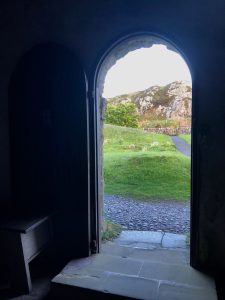
Finding Your Thinplace Pilgrimage Aug 28-Sept 4th
©lillylewin and freerangeworship.com
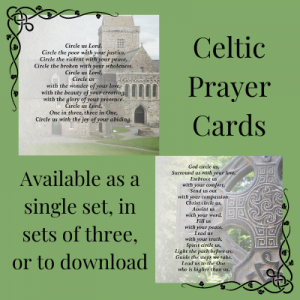 Celtic Prayer Cards include 10 prayers inspired by ancient Celtic saints like Patrick or contemporary Celtic writers like John O’Donohue. A short reflection on the back of each card will introduce you to the Celtic Christian tradition, along with prayers by Christine Sine and beautiful imagery crafted by Hilary Horn. Celtic Prayer Cards can be used year-round or incorporated into various holidays. Available in a single set of 10 cards, three sets, or to download.
Celtic Prayer Cards include 10 prayers inspired by ancient Celtic saints like Patrick or contemporary Celtic writers like John O’Donohue. A short reflection on the back of each card will introduce you to the Celtic Christian tradition, along with prayers by Christine Sine and beautiful imagery crafted by Hilary Horn. Celtic Prayer Cards can be used year-round or incorporated into various holidays. Available in a single set of 10 cards, three sets, or to download.
Writing and photos by Carol Dixon, music with permission from Rev. Sheila Hamil and Carol Dixon.
The 2nd of February is the feast of Candlemas, and is when many churches have a service to bless the candles that will be used throughout the year in worship and celebrate Jesus as the light of the world. It is also seen as the start of a new season and our opening hymn speaks of God with us in all seasons.
Great is Thy Faithfulness
Prayer
God of light and love, warming February’s chill,
Tempering the winds, peppering the hard ground
With early shoots of green and hints of blossom,
We lift to you the cold bones of winter and hearts aflame with hope.
We praise you for the light that has arrived with Jesus,
Shining in the darkness, unquenchable and true.
We praise you for the hope of his presence
Guiding our feet and lighting our pathway,
Casting warming rays and glow of fulfilment.
We praise you for the discomfort of his searchlight beams,
Concealing nothing, truth telling, life changing.
Examine us and know us God.
Drive out the darkness, turn our hearts to you
And fill our souls with the song of salvation,
With the message of your love.
Holy God, we worship you. We sing your praise, now and forever. Amen.
– [from Spring ed by Ruth Burgess Iona books]
As in many churches in the UK, in Sweden (where my penfriend of over 60 years lives,) Candlemas is celebrated in the churches as a Candle Feast. This is family service with candle lighting ceremonies, and children bring their christening candles and light them in the service to remember their baptism. In the middle ages the households of the parish brought their dipped candles to get them blessed at the altar candles. Candlemas Day is also a celebration of church music in Church of Sweden and a special song is sung.
(apologies no words available)
Some people have the Christmas lights in their windows lit until Candlemas which is seen as the last day of the Christmas ecclesiastical period.
Special festivals for Candlemas in Europe include pancakes (France, parts of Belgium), singing for sweets or cakes (Luxembourg) and church processions on the Sunday nearest February 2nd (Sweden & parts of Swedish speaking Finland) (Candlemas in Swedish Traditions).
Another symbol of Candlemas is the snowdrop which is usually the first flower to defy the winter. In some countries in the northern hemisphere Candlemas is seen as opening the door to spring.
I loved Lily Lewin’s Freerange Friday about opening doors and today I want to think about opening doors in our lives. One way we can do be more open to God is by meditative listening to the Bible read aloud and today I invite you to read aloud the readings below from a few different translations and consider which one resonates most with you. Holman Hunt’s famous painting ‘Light of the world’ was inspired by this passage from Revelation 3:20, 22. Let’s listen for God’s word to us today in scripture and in song.
Behold, I stand at the door and knock. If your heart is open to hear my voice and you open the door within, I will come in to you and feast with you, and you will feast with me…22The one whose heart is open let him listen carefully to what the Spirit is saying now to the churches. [The Passion Translation]
Listen! I stand at the door and knock; if any hear my voice and open the door, I will come into their house and eat with them, and they will eat with me…22If you have ears, then, listen to what the Spirit says to the churches!” [Good News Bible]
“Look! I stand at the door and knock. If you hear my voice and open the door, I will come in, and we will share a meal together as friends… 22Anyone with ears to hear must listen to the Spirit and understand what he is saying to the churches.” [New Living Bible]
“Look at me. I stand at the door. I knock. If you hear me call and open the door, I’ll come right in and sit down to supper with you…22Are your ears awake? Listen. Listen to the Wind Words, the Spirit blowing through the churches.” [The Message]
Behold I Stand and Knock (Sheila Hamil)
Jenneth Graser (another godspacelight writer) wrote a lovely book on coming to God in prayer called Unlocking the Secret Garden: 100 Days of Imaginative Prayer. She begins by saying ‘Imagine you are standing before the threshold of an intricately carved wooden door surrounded by hanging creepers, mosses and ferns. Take note of how you feel as you stand there – what can you hear or see around you as you turn the key and walk into a cathedral of trees, light and a carpet of small flowers. It is time to open the secret garden within your heart and spend time with Jesus.’
As you open doors in your own house, going in and out this week, think about the doors Jesus is opening for you. Ask Jesus to open new doors of creativity, hope, inspiration, joy, compassion for you as the season unfolds! Watch for new doors of opportunity and how they bring you closer to God and help you to bring others to Jesus.
Some years ago I had a dream at the turn of the year. I saw before me a door of frosted glass with distorted images on the other side and I was afraid to turn the handle and open the door and walk through. On waking I asked God to give me the vision to overcome my fear and walk boldly through into this new world and he gave me a hymn which you can read here.
Give us the Vision (Carol Dixon)
Prayer
Steadfast loving God, thank you for your everlasting love for us.
We seek to be bringers of your peace, your love
and forgiveness to our hurting world.
Help us to open the doors of our church
And the doors of our hearts to all people,
And invite them in, no matter who they are.
Give us courage to step out of our comfort zones
And welcome those who may be different from ourselves.
Help us to open the doors of our lives to you.
Strengthen our faith so that we may rely on you each day
For all that we need to live, and learn to serve you
Following the example of Jesus.
Help us to protect our environment and share our resources
Using them to bring about your commonwealth of love.
We bring to you today people and situations that concern us,
Thinking especially of those we know and love (time of silent prayer)
Steadfast loving God, we thank you for always hearing our prayers
And giving us your peace to share with all we meet. Amen.
This final hymn is one I learned from my granny. I used to go to her house for tea on Sundays and after we had eaten our tea cakes toasted over the fire on a long fork we used to have a little service with a Bible reading, a prayer for God’s blessing on the coming week and a couple of old Wesleyan hymns. She sometimes invited me to lead worship (maybe that’s why I became a lay preacher!) and used to say ‘Never forget, Carol, to invite Jesus into your heart every day’.
Come into my heart Lord (Tune Hear the pennies dropping)
Come into my heart Lord, come to me today,
Come into my heart Lord and forever stay,
Come into my heart Lord I invite you in
Fill me full of love and take away my sin.
Come into our lives Lord, come to us today
Come into our lives Lord, and forever stay,
Help us all to follow in your footsteps lord
Love and care for others, share with them your word.
Come into our world Lord, come and make it new.
Come into your world Lord, may all follow you,
Loving, serving, giving, bringing hope to all,
Living in your kingdom, answering your call.
- (Author unknown based on hymn learned from my granny)
Blessing (from Psalm 121)
May the Lord watch over our coming in and going out from this day forth and forevermore.
And may the peace of God fill our lives today and every day.
Amen.
 Did you know that alongside Christine Sine’s book The Gift of Wonder, we have many resources available to you? The free downloadable bonus packet or beautiful prayer cards featuring prayers from the book, for example – something to hold and behold! Or perhaps you’d like to journey through the book alongside a retreat – we have that too! You can check it all out in our shop!
Did you know that alongside Christine Sine’s book The Gift of Wonder, we have many resources available to you? The free downloadable bonus packet or beautiful prayer cards featuring prayers from the book, for example – something to hold and behold! Or perhaps you’d like to journey through the book alongside a retreat – we have that too! You can check it all out in our shop!
Happy St. Brigid’s Day! Her feast day is February 1 but it can rightly be celebrated the entire first week of February. This year I am feeling Brigid’s energy circulating throughout our world. Yes, she is calling us to the hope of the coming season of spring in the northern hemisphere. But if you listen a little more deeply, you can hear her proclaiming the Celtic Christian understanding that God is in everything and everyone. And with that call comes her invitation to pattern our lives after the witness of Jesus of Nazareth.
St. Brigid, 473-524 (approximate dates) was born in Ireland. She was the daughter of a druid poet and a Christian slave servant. Remembered as a fine monastic leader, her monastery was built in Kildare. It soon became a double monastery as she presided over both men and women. The monastery was famous for their generous hospitality and their compassionate care for the sick, the poor and the oppressed. Brigid is also remembered as a healer and one who offered spiritual guidance to others and promoted the ministry of soul friendship. She was also a peacemaker. She intervened in disputes between rival clans, bringing reconciliation. St. Brigid is depicted in an icon in the parish church in Kildare with her foot on a sword.
My feature photo is one that I took in the garden well of St. Brigid, Kildare. The statue depicts her holding a lit torch of fire in front of water that flows from her well. Thus, St. Brigid is revered as a keeper of sacred water and sacred fire. Hundreds of wells bearing her name can still be found in Ireland, Scotland and England.
As a keeper of fire, she and her nuns were guardians of an eternal flame which they kept burning within their monastery. It is said that even after St. Brigid’s death they kept the flame alive for a thousand years until it was extinguished when all monasteries were shut down in the sixteenth century. And yet that flame has been rekindled and the light that inspired Brigid is burning brightly!
I can testify that Brigid’s spirit is truly alive today. In 2016 I travelled to Kildare and visited her cathedral and garden well. Both made a deep impression. What was surprising was encountering her likeness in many of the village shops. I saw paintings and mosaics bearing her image. Her cross was seen in several of the businesses in town. A pub offered a beer called, “Brigid’s Brew.” The town seemed to have embraced Brigid as their town saint. Her presence has continued to grow in Kildare.
Recently I visited Kildare virtually. My visit turned out to be a pilgrimage at the website of Solas Bhríde which is a Christian Spirituality Centre of the Brigidine Sisters.
The story of Solas Bhríde began in 1992 when two Brigidine Sisters moved to Kildare with the intent to share the legacy and spirit of Brigid with the world, in and through the town of Kildare. In 1993 the eternal flame of Brigid (mentioned above) was re-lit in the center of the town and a spark from that fire was carried from the town back to the home where the two Sisters lived. Since that time, the Brigidine Order has built an impressive spirituality center which houses educational, artistic, literary and spiritual programs about St. Brigid and of course the eternal flame.
Each year, Solas Bhríde and the town of Kildare celebrate the Festival of St. Brigid. This year the festival will last an entire week, beginning on the eve of her feast day, and running from January 31 through February 7. There are many events, ranging from educational lectures, performing and visual arts presentations, a candlelight pilgrimage, a guided labyrinth walk, a circle dancing, worship, presentations on social justices, ecumenical worship and meditation. And there is more! Here is the link to see the marvelous things this year’s festival has to offer.
None of this would have been possible without the collaboration between the Centre and the town. The festival and other activities throughout the year are sponsored by the City Council, other civic groups and an important non-profit group devoted to promoting peace and social justice. I find this to be amazing and inspiring! It is an actual collaboration between a town and a religious group bent on being a light to and in the world. The town and Solas Bhríde are embodying the Centre’s stated mission: “To share the Christian Celtic tradition which is a spirituality nourished by ritual, tradition, contemplation, experience and story.”
As I perused the pages detailing the festival, I found one way in which I can participate in the festival– and so can you!
The event that I will be participating in is a meditation from the Solas Bhríde team described as “looking towards the light and renewed hope this Springtime.” It will be offered at the Centre and is an in-person as well as an online event. The date is February 6 at 7:30 p.m. – 8:15 p.m. (GMT). If you would like to register, write the Centre at info@solasbhirde.ie. I have done so and have received my Zoom Link and look forward to being there. I hope you will join me.
Finally, here is one of my favorite stories about St. Brigid. She approached the local king of the region of Kildare to ask for land on the plain of Curragh so that she could build her monastery. He grudgingly told her she could have as much of the area as her cloak would cover. Brigid laid out her mantle on the ground, and the king watched in horror as it began to spread rapidly over the plains for miles and miles. It had almost covered the whole country by the time he begged her to stop. In Kindling the Celtic Spirit, Mara Freeman says, “Perhaps this story holds the memory of the time when all of Ireland was held within the fold of Brigid.”
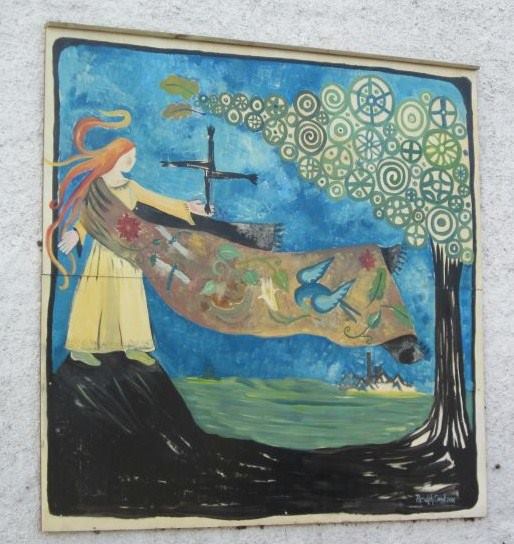
Indeed. It seems to me that the mantle of Brigid is continuing to spread across the world. Solas Bhríde has received visitors from almost every country, including the Dalai Lama who visited there once and can be seen on the website holding a Brigid’s Cross with his characteristic smile!
I also believe that Brigid’s mantle is growing in ways that transcend geography. In Ireland, on February 6, 2023, the country will hold its first national public holiday, specifically in the name of St. Brigid. Wow!
Many stories about the life of St. Brigid demonstrate that everything she put in her hand seemed to increase. A medieval Irish hymn to Brigid, concludes, “Now in heaven she intercedes for us, sending upon us the gentle dew of God’s grace.”
I have no doubt that Brigid’s mantle has the power of the Holy Spirit to embrace and transform our world. Apparently, all she needs is just a little help from the rest of us.
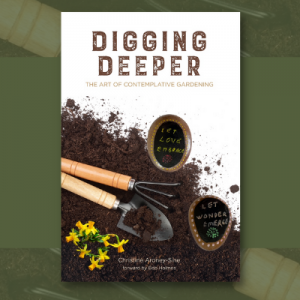 Digging Deeper: The Art of Contemplative Gardening
Digging Deeper: The Art of Contemplative Gardening
Are you yearning to Dig Deeper? Perhaps you are looking for refreshment in your contemplative practices or for creativity in prayer. Christine Sine’s latest book is packed full of contemplative wisdom and inspiration for creating your own meditative focus. Click for more details!
Dear Friends,
Wow – it’s the end of January. Here in Seattle the days are lengthening and I am starting to plant seeds. Spring may not be in the air but it is certainly in my mind. So is Lent and Easter. Ash Wednesday is coming fast. Lent begins February 22nd. As well as that Black History Month (February) is almost on us, followed in March by Women’s history month. This is a busy season of celebrations and commemorations – Brigid of Ireland, Candlemas and Imbolc are rapidly approaching. For those that are unfamiliar with it, Imbolc is a well known Celtic tradition stemming from Neolithic Ireland and Scotland. It celebrates the halfway point between Winter Solstice and Spring Equinox. Imbolc and Candlemas February 2nd are a celebration of light and the first spark of spring.
Over the weekend I had fun creating an array of St. Brigid crosses as preparation for candlemas and St Brigid’s feast day which I talk about in my Mediation Monday: Imbolc, St Brigid and Candlemas. All the instructions you need for this simple craft are in the post, as is information on the celebrations of February 1st and 2nd.
For Orthodox Christians next Sunday is also the beginning of Triodion, which shares its name with the liturgical book containing the hymns and services for the period from now until Holy Saturday. It begins with the Sunday of the Publican and Pharisee and moves through progressive Sundays highlighting the story of the Prodigal Son, Last Judgement and forgiveness. For more information check out Ascetic Life of Motherhood. I love the suggestion that we need to take the weeks before Lent to prepare our hearts and minds for the season. It is such an important time in the celebration of our faith and we need to give it our full attention now.
What are you planning to do for Lent? On Godspacelight we have updated our resource lists, or you might like to start by checking out this list of Lenten prayers posted over the years. You might also like to revisit our last year’s Lenten retreat Finding Beauty in the Ashes of Lent. This retreat and the practices we suggested impacted me so much that they will form the foundations for my practices this year too. You might like to check out our Lenten devotionals and free downloads in the Godspacelight store as well. Also save the date for this year’s Lenten retreat – Preparing for the Garden Walk of Holy Week. This will be a quiet, contemplative retreat, though there will be time for creativity as well. The retreat will be on Saturday, March 25th.
Getting ready for Black History month is much harder for me than the preparation for Lent. The recent horrific death of Tyre Nichols and the many injustices that black people still face on a daily basis here in the U.S. overwhelms me. My heart aches constantly for all people of color in this country as well as for the many around the world who face injustice because of their color or ethnicity. Our resource list on Racial Reconciliation, though fairly comprehensive, still needs updating so if you have suggestions please let me know. My go to people for resources on racial reconciliation are Lisa Sharon Harper and Brenda Salter McNeill, two amazing women of color who help keep me informed and struggling with these issues.
I am also extremely concerned about the impact of climate change on our world. The recent deluge in Auckland, NZ is but one of many that has inundated our planet in the last few weeks. We pray for all who have suffered from these horrendous floods. It challenges me to consider how else I might need to change my lifestyle to reduce my impact on the earth. You might like to meditate on this garden liturgy as you too consider what you could do.
Many blessings on you as you navigate the week ahead.
Christine Sine
Lent is getting closer, and now is a great time to prepare for the upcoming season. Check out our Lent and Easter resource lists for prayers, creative ways to celebrate as a family, and more! More info on our resource page: Lent & Easter or find resources in our shop.
As an Amazon Associate, I receive a small amount for purchases made through appropriate links.
Thank you for supporting Godspace in this way.
When referencing or quoting Godspace Light, please be sure to include the Author (Christine Sine unless otherwise noted), the Title of the article or resource, the Source link where appropriate, and ©Godspacelight.com. Thank you!

